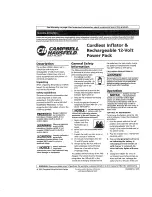
VII. GROUNDING
1. In the event of a malfunction or breakdown, grounding reduces the risk of electric shock. This tool is
equipped with an electric cord having an equipment-grounding conductor and a grounding plug. The plug
must be plugged into a matching outlet that is properly installed and grounded in accordance with all local
codes and ordinances.
2. Do not modify the plug provided if it will not fit the outlet, and have the proper outlet installed by a qualified
electrician.
3. Improper connection of the equipment-grounding conductor can result in a risk of electric shock. The equip-
ment-grounding conductor is green with or without a yellow stripe. If repair or replacement of the cord or
plug is necessary, do not connect the equipment-grounding conductor to a live terminal.
4. Check with a qualified electrician or serviceman if the grounding instructions are not completely understood,
or if in doubt as to whether the tool is properly grounded.
5. Use only 3-wire extension cords that have 3-prong grounding plugs and 3-pole receptacles that accept the
tool's plug.
6. Repair or replace damaged or worn cord immediately.
7. For 115V Models:
This tool has a grounding plug and is intended for use in outlets as illustrated in sketch A. A temporary
adapter, as illustrated in sketches B and C, may be used to connect this plug to a 1-pole receptacle as
shown in sketch B if a properly grounded outlet is not available. The temporary adapter should be used only
until a properly grounded outlet can be installed by a qualified electrician. The green-coloured rigid ear, lug,
etc. extending from the adapter must be connected to a permanent ground such as a properly grounded out-
let box.
NOTE:
The type of electrical plug and receptacle differs from country to country.
CAUTION:
In Canada, only the grounding shown in figure (A) is acceptable. The extension cords should be
CSA certified S.J.T. type or something better.
–9–





























